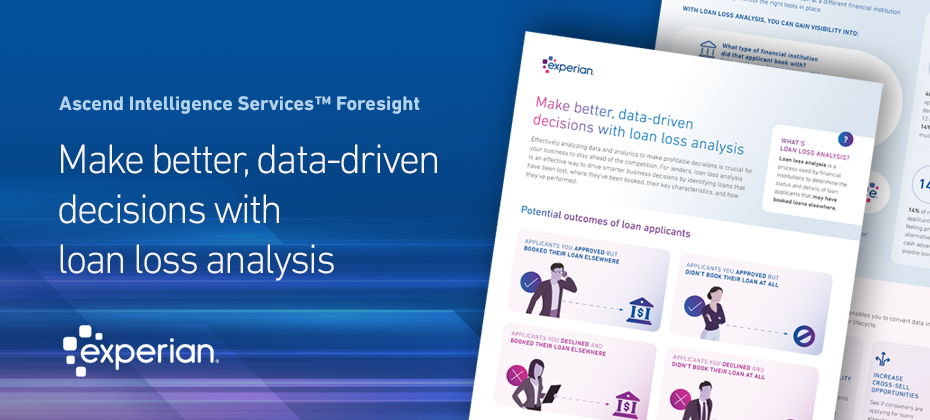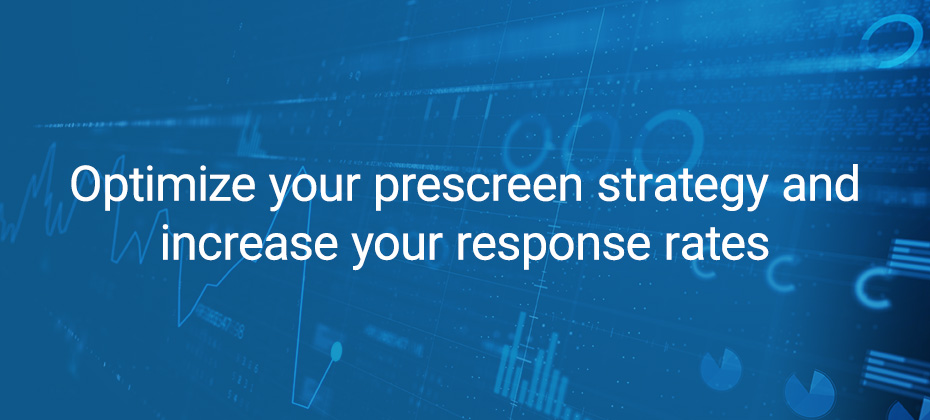Topics

For financial institutions to achieve success, they need to develop high-performing models with easy access to top-tier data sources. It’s also important to focus on data governance, compliance, and risk management throughout the lending lifecycle. Industry leaders implement advanced analytics and AI solutions to improve their lending decisions, and they also incorporate integrated, efficient feature engineering into their business operations. What’s feature engineering? Feature engineering helps organizations turn raw data into comprehensive model development, following this process: Data collection Data cleaning and transformation Feature engineering Model training and evaluation Decision-making Effectively transforming data into valuable insights depends heavily on creating new custom features to enhance model performance, as well as the quality of the data being used. When data is fragmented or managed poorly, it can lead to increased operational costs, missed revenue opportunities, and compliance risks. Our feature engineering solution: Experian Feature Builder Financial institutions require optimized workflows that can accelerate development while supporting governance and ensuring transparency. Experian’s feature engineering tool, Experian Feature Builder, streamlines custom feature development and deployment across the modeling lifecycle. Providing access to 20+ years of proprietary data, Experian Feature Builder enables organizations to: Break data silos by creating unified access across multiple data types Ensure trust and compliance by embedding audit and lineage tracking at each stage Enable strategic agility with faster and more consistent feature experimentation, testing, and deployment Download our latest e-book to find out more about how Experian’s Feature Builder provides centralized feature development to accelerate time-to-market, enhance compliance, and minimize risk. Download the e-book

Generative AI (GenAI) is transforming the financial services industry by boosting operational efficiency, cutting costs, and enhancing customer experience. Today, industry leaders are leveraging GenAI technology to accelerate the modeling lifecycle, streamline workflows, and ensure regulatory compliance. However, financial institutions face several headwinds in their efforts to achieve strong business results. What industry challenges do financial institutions face? To drive profitability while fueling growth, organizations need to reduce costs, manage risks, and identify new revenue streams while complying with regulatory requirements. Growing customer bases are also a top priority for banking leaders in 2025, requiring personalized services and improved customer experiences to attract and retain customers.1 Staying one step ahead of the competition is another hurdle that many organizations need to overcome. A recent study states that 23% of U.S. consumers surveyed have opened a new bank account, and 28% have considered switching to a new bank in the past six months.2 Traditional financial institutions must continuously innovate to stay on pace with smaller, more agile fintech companies. Adopting technologies like GenAI is an effective way to stay relevant and top-of-mind with consumers. Why use GenAI technology in financial services? Financial organizations that use GenAI are achieving success by: Increasing productivity and efficiency Minimizing costs Strengthening customer relationships GenAI has revolutionized productivity, customer service, risk management, and financial data analysis within the financial services industry. Of all the various measurements of AI use, improved productivity was reported to be the leading indicator of successful implementation.3 Online tools like virtual assistants and chatbots provide personalized experiences to consumers and resolve issues in real time, leading to enhanced customer satisfaction. This AI technology reduces the workload on human agents and enables organizations to deliver value more quickly and with less friction. GenAI adoption at Experian Experian® is a leader in GenAI solutions, using advanced technology to manage and improve data. We champion responsible AI use, ensuring proper consumer data privacy, compliance, fraud prevention, and greater financial access and inclusion. Experian Assistant is our latest innovation in GenAI helping financial institutions to accelerate the modeling lifecycle, which enhances efficiency, reduces expenses, and promotes customer growth. Experian Assistant allows businesses to build and deploy models, monitor performance, and go to market more quickly and with less friction, which can translate to more business success. The tool provides instant expert recommendations and insights with comprehensive support, enabling users to make smarter and faster data-driven decisions. This technology offers multiple functions that are crucial for optimizing business efficiency: Natural language interface Deep insights into underlining data tables and metrics Reduced operational and cloud expenses Decreased risk of penalties Read our latest white paper to discover more about how our latest GenAI innovation, Experian Assistant, is empowering organizations to drive business growth and profitability. Read the white paper 1 BAI, 2025. Acquiring new customers and growing quality deposits are the top business challenges in 2025. 2 MX, 2023. What Influences Where Consumers Choose to Bank. 3 Forrester, Q2 AI Pulse Survey, 2024.

Managing credit limits effectively can be a game-changer for both consumers and financial institutions. Understanding the benefits and behaviors associated with increased credit limits helps in appreciating the long-term impacts of this strategy. Proactive credit limit management offers numerous advantages that can significantly improve financial health and stability.

Managing credit limits effectively is vital for maintaining a profitable and resilient credit card portfolio. By adopting a proactive credit limit management approach, financial institutions can significantly improve customer satisfaction and increase revenue. As of Q3 2024, the average credit card limit in the U.S. stood at $32,025, marking a 4.1% rise from $30,763 the previous year.1 Proper management of these limits is crucial for financial institutions, as it impacts consumer borrowing capacity and overall financial health. Advantages of proactive credit limit increases A proactive credit limit increase occurs when a credit card issuer raises a cardholder’s credit limit without their request. This action is usually dependent on improvements to cardholders’ creditworthiness, including consistent, on-time payments and a reduction in debt. Proactive increases can enable financial institutions to: Increase interchange income: When financial institutions increase credit limits, they can boost transaction volumes, leading to higher interchange income. Generate additional interest income: Higher credit limits can lead to increased borrowing, resulting in more interest income for financial institutions. Enhance wallet share: By proactively increasing credit limits, institutions can encourage cardholders to use their cards more frequently, thereby increasing wallet share. Reduce customer attrition: When cardholders feel valued and supported, they are more likely to remain loyal to their financial institution. Proactive credit limit increases can reduce attrition rates by enhancing customer satisfaction and loyalty. Improve customer experience: Cardholders value the convenience and flexibility of higher credit limits, which can lead to increased satisfaction, positive sentiment and potential referrals. Implementing proactive credit limit increases To successfully implement proactive credit limit increases, financial institutions must address two key questions: Who receives an increase? Use insights to identify cardholders who meet the criteria for credit limit increases. Continuously monitor cardholders’ creditworthiness using advanced tools and technologies to ensure that only responsible cardholders receive increases. How much of an increase? Determine customers’ ability to afford additional credit by evaluating their annual income, debt-to-income ratio, and payment-to-income ratio. Set thresholds for these metrics to guide the decision-making process. Proactive credit limit management Effective credit limit management is essential for financial institutions aiming to grow their credit card portfolios and enhance customer satisfaction. Read this e-book on proactive credit limit management and discover how your institution can improve wallet share, enhance customer experience, and drive revenue. Read the e-book 1 Experian, Average Credit Card Debt Increases 3.5% to $6,730 in 2024.

What is feature engineering? Feature engineering helps organizations turn raw data into comprehensive model development. This process depends heavily on creating new custom features to enhance model performance, as well as the quality of the data being used. When data is fragmented or managed poorly, it can lead to increased operational costs, missed revenue opportunities, and compliance risks. The necessity of integrated feature management Feature engineering is essential for financial institutions to identify valuable features that provide significant insights and predictive power in various analytics applications. By integrating feature engineering into the feature lifecycle, organizations can convert raw data into more accurate and value-driving features, better manage features for audit purposes and compliance efforts, and build higher-performing models. At Experian, we have developed a unified feature engineering solution that integrates capabilities across various tools such as the Ascend Analytical Sandbox™ and Ascend Ops™. This comprehensive approach streamlines the feature engineering process, making it more efficient and effective in supporting the complete feature lifecycle. The challenges in feature engineering 54% of source data used by financial institutions for credit decisioning is not model-building ready.1 Financial institutions need access to high-quality data sources and the ability to modify and combine data to make more profitable data-driven decisions. In addition, organizations need the necessary tools to solve the myriad of challenges involved with feature engineering. These challenges include: Costs: Sourcing and centralizing data can be expensive, and managing and updating data definitions for engineering and analytics is costly. Collaboration: Managing a centralized feature library is difficult and often skipped. As AI and analytics teams become more complex across the enterprise, maintaining and governing feature definitions in a centralized library is a must-have. Inconsistencies: Calculating features can vary. Different calculations in development and production use cases across the lending lifecycle create model risks and compliance issues. Governance risks: Tracking lineage of data definitions is important to avoid elevating risks. Data engineers and scientists need to visualize upstream and downstream impacts as they modify feature definitions. Resources: Teams often have skills gaps and require additional expertise, as they may lack an understanding of automated credit reports amongst resources. Integration: Evaluating and integrating features into the analytics lifecycle is difficult. This can hinder understanding of the value of models and strategies throughout the lending lifecycle and create friction at deployment. Experian Feature Builder: a comprehensive solution Experian Feature Builder is a modern, integrated custom feature solution that combines development, deployment, and management technologies. It accelerates the feature lifecycle through efficient data management and streamlined end-to-end workflows. Users can access the Ascend Analytical Sandbox for custom feature development and seamless connection to Ascend Ops for deployment and ongoing management. This integration also significantly enhances compliance and governance by adding a layer of visibility into feature performance, thereby reducing risks through feature monitoring. Leveraging best-in-class technologies Feature Builder Notebooks enables users to review feature code in Jupyter Notebooks within Ascend Analytical Sandbox, explore data, execute small sample feature calculations, examine feature distributions, edit feature code, and register to the feature library. Feature Builder Studio enables users to review and manage features in the feature library, set up feature calculation jobs, and define feature sets for deployment. Users can also add Ascend Ops to deploy to production with little to no friction. Supporting advanced analytics in consumer credit with integrated feature management Experian Feature Builder provides a centralized feature library, ultimately improving time to market and decisions to extend credit while managing default and fraud risks. Centralized access to data sources used in custom features and intermediation of third-party data sourcing. Advanced lineage tracking for a clear view of the history of upstream and downstream feature dependencies for governance purposes. Streamlined feature registry for built-in version management and tracking with feature correlations and distributions. Key statistical reporting for out-of-the-box data visualizations and monitoring of feature correlations and distributions. Comprehensive feature lifecycle support through integration with Ascend Analytical Sandbox for rapid analytics use case iteration and experimentation as well as production-grade execution and deployment with Ascend Ops. The future of feature engineering Understanding how essential feature engineering is in producing value-driving features, managing and monitoring features for audit and compliance purposes, and more predictive and high-performing models is pivotal to maintaining competitiveness in the financial services industry. Experian Feature Builder is the future of feature engineering. With integration for advanced analytics, model development through deployment, and enhanced feature management capabilities supporting compliance and governance, Experian Feature Builder supports the complete feature lifecycle. To learn more about how Experian Feature Builder can revolutionize your feature engineering, please visit our website and book a demo with your local Experian sales team. Learn more about Feature Builder 1 Experian research 2023

Lending institutions need to use the right business strategies to win more business while avoiding unnecessary risk, especially regarding lending policies. A recent study revealed that 48% of American loan applicants have been denied over the past year, with 14% facing multiple rejections. Additionally, 14% of rejected applicants felt pressured to seek alternative financing like cash advances or payday loans.1 These statistics highlight the need for financial institutions to offer attractive loan options to stay ahead in the industry. Understanding loan loss analysis Loan loss analysis is a powerful tool that helps lenders gain insights into why applicants book loans elsewhere. Despite efforts to target the right consumers at the right time with optimal offers, applicants sometimes choose to book their loans with different institutions. The lack of visibility into where these lost loans are booked can hinder a lender’s ability to improve their offerings and validate existing policies. By leveraging loan loss analysis, lenders can turn valuable data into actionable insights, creating more profitable business opportunities throughout the entire customer lifecycle. Gaining deep consumer insights Loan loss analysis provides visibility into various aspects of competitors’ loan characteristics, such as: Type of financial institution: Identifying whether applicants prefer banks, credit unions or finance companies can help lenders tailor their offerings. Average loan amount: Understanding how much other institutions offer allows lenders to adjust their loan amounts to be more competitive. Interest rates: Comparing interest rates with competitors helps lenders calibrate their rates to attract more business. Loan term length: Knowing the term lengths offered by competitors can inform decisions on loan terms to make them more appealing. Average risk score: Determining the risk scores of loans booked elsewhere helps lenders optimize their policies to maximize earning potential without increasing default risk. Making profitable decisions with business intelligence Experian's loan loss analysis solution, Ascend Intelligence Services™ Foresight, offers comprehensive insights to help lenders: Book more loans Increase profitability Enhance acquisition strategies Improve customer retention Optimize marketing spend By determining where applicants ultimately book their loans, lenders can unlock deep insights into competitors’ loan characteristics, leading to more intelligent business decisions. Read our latest e-book to discover how loan loss analysis can help you gain visibility into competitor offerings, improve your lending policies, book higher-performing loans, and minimize portfolio risk. Read the e-book Visit our website 1 Bankrate, February 2025. Survey: Almost half of loan applicants have been denied over the past 12 months.

Loan loss analysis helps financial institutions identify the characteristics and performance of loans that have been lost to competitors.

Customer retention is crucial for lenders to maximize lifetime value, especially during economic uncertainty. Increasing customer retention rates by just 5% can boost profits by 25% to 95%. However, many lenders struggle with loyalty, as seen in Q2 2024 when mortgage servicers’ retention rates for refinances dropped to 20%, the second lowest in 17 years. Nonbanks and banks also saw significant declines. This is due to increased competition, changing economic conditions, and a lack of personalization. Key strategies for improving customer retention Lenders can improve retention by leveraging data for personalization, maintaining consistent communication, offering loyalty rewards, and utilizing retention triggers. Leverage data for personalization. Use customer data to offer tailored products and refinancing options based on financial behaviors. Using credit attributes, trended data and alternative credit data (alternative financial services data, cashflow attributes, etc.) can help provide deeper insights of your customers. Maintain consistent communication. Keep customers informed with regular updates about interest rate changes or new loan products. Use a variety of communication channels, including email and in-app messaging, to ensure customers are kept in the loop. Ensure your customer service team is always available and responsive, offering clear answers to any financial concerns. Offer loyalty rewards. Develop programs that reward repeat business and referrals. Offer special rates or discounts for returning customers or for those who refer friends and family to your services. Increase customer lifetime value (LTV) by offering additional services like financial planning or credit score monitoring. Utilize retention triggers. Identify key events for engagement with automated retention triggers. For example, a borrower who has a mortgage with a fixed rate may be less likely to consider refinancing unless prompted. Experian’s Retention TriggersSM can notify lenders when refinancing might be beneficial to their customer, offering them personalized incentives or new product options at the right time. Why Experian’s Retention Triggers? By integrating Experian’s Retention Triggers, lenders can keep borrowers engaged, increase retention, and boost profitability even in tough economic times. Advanced data insights: Gain deeper insights into your customers’ behavior to identify those at risk of leaving and take proactive action. Personalized engagement: Automate personalized communications based on customer behaviors, ensuring timely engagement. Increased revenue: By offering personalized, timely and relevant offers, you can increase the likelihood of retaining your customers and growing your revenue. Make customer retention a priority In today’s challenging economic climate, lenders who focus on personalized experiences, consistent communication, and relevant offers will stand out and retain borrowers. Leverage tools like Experian’s Retention Triggers to proactively engage customers, reduce churn, and foster long-term relationships for increased profitability and success. Learn more

Consumers are experiencing the highest loan rejection rates in a decade, driven by strict lending standards.1 While crucial for mitigating risk, these measures can also limit growth opportunities for financial institutions. Our latest one pager explores how cash flow data, obtained from consumer-permissioned transaction data, empowers lenders with unique insights into consumers’ financial health, enabling them to expand their portfolios while managing risk effectively. Read the full one pager to learn how cashflow data can help you make smarter, more confident lending decisions. Access one pager 12024 Q4 Lending Conditions Chartbook, Experian.

Many organizations remain committed to financial inclusion to create better outcomes for underrepresented consumers and small businesses by unlocking barriers to financial well-being and closing the wealth gap. Organizations like credit unions, Community Development Financial Institutions (CDFIs), and Minority Deposit Institutions (MDIs) live by these values. These lenders work hard to ensure these values are reflected in the products and services they offer and in how they attract and interact with customers. While funding from the federal government is being scaled back for many of these community-based financial institutions, Experian is scaling up! We're still here to support CDFIs, Credit Unions, and their members, along their financial inclusion journey. The cross-walk between DEIB and financial inclusion Although Diversity, Equity, Inclusion and Belonging (DEIB) and financial inclusion involve different strategies, there’s an undeniable connection that should ultimately be tied to a business’s overall goal and mission. The communities that are historically underrepresented and underpaid in the workforce – including Black Americans, Hispanic/Latinos, and rural white Americans – also tend to be marginalized by the established financial system. Financial institutions that work to address the inequities within their organizations and promote financial inclusion may find that these efforts complement each other. DEIB policies help promote and support individuals and groups regardless of their backgrounds or differences. While financial inclusion is less specific to a company or organization, instead it describes the strategic approach and efforts that allow people to affordably and readily access financial products, services, and systems. The impact of financial inclusion Lenders can promote financial inclusion in different ways. A bank can change the requirements or fees for one of its accounts to better align with the needs of people who are currently unbanked. Or it can offer a solution to help people who are credit invisible, or unscoreable by conventional credit scoring models, establish their credit files for the first time. Financial institutions also use non-traditional data scoring to lend to applicants that conventional scoring models can’t score. By incorporating alternative credit data[1] (also known as expanded FCRA-regulated data) into their marketing and underwriting, lenders can expand their lending universe without taking on additional risk. Financial inclusion efforts for all Experian is a champion of financial inclusion by supporting both financial institutions and consumers. Through our Inclusion Forward – Experian Empowering Opportunities™ initiative, we work directly with lenders to reach underserved communities and extend greater credit access to consumers. We also offer various tools to help consumers build and understand their credit, and to help financial institutions reach underrepresented communities. We provide individuals with everything from financial inclusion solutions to literacy education to insights about their own financial profile, along with ways to help underrepresented communities improve their financial wellness.* One way that we are doing this is through our consumer programs called Experian Go® and Experian Boost® –that are available for free through the Experian app. These first-of-their-kind programs work together to help consumers improve their credit profile. Experian Go helps individuals establish a credit file, while Experian Boost assists with adding tradelines to an existing credit file. For example, with Experian Boost, individuals can connect positive payments to utility, rent, streaming services, and other accounts to improve their credit scores. Membership with Experian helps consumers monitor their credit, manage their money, and find ways to save money, including shopping for insurance. In fact, consumers saved an average of $828 per year when they switched and saved through Experian Insurance Marketplace.[2] Working together to create financial empowerment There’s no magic solution to undoing the decades of policies and prejudices that have kept certain communities unable to fully access our financial and credit systems. But financial institutions like credit unions, CDFIs and MDIs take steps every day to drive financial inclusion and help underrepresented communities. These values are a part of their business DNA, and Experian is here to help keep their legacy alive. Whether you’ve established your strategy or need help with implementation, we can help you enhance your financial inclusion efforts. Learn more about our helpful solutions. Experian will point you in the right direction to business growth. Visit our website [1] Using Alternative Credit Data for Credit Underwriting. [2] Experian research. *Experian Boost: Results will vary. Not all payments are boost-eligible. Some users may not receive an improved score or approval odds. Not all lenders use Experian credit files, and not all lenders use scores impacted by Experian Boost. Learn more.

Fake IDs have been around for decades, but today’s fraudsters aren’t just printing counterfeit driver’s licenses — they’re using artificial intelligence (AI) to create synthetic identities. These AI fake IDs bypass traditional security checks, making it harder for businesses to distinguish real customers from fraudsters. To stay ahead, organizations need to rethink their fraud prevention solutions and invest in advanced tools to stop bad actors before they gain access. The growing threat of AI Fake IDs AI-generated IDs aren’t just a problem for bars and nightclubs; they’re a serious risk across industries. Fraudsters use AI to generate high-quality fake government-issued IDs, complete with real-looking holograms and barcodes. These fake IDs can be used to commit financial fraud, apply for loans or even launder money. Emerging services like OnlyFake are making AI-generated fake IDs accessible. For $15, users can generate realistic government-issued IDs that can bypass identity verification checks, including Know Your Customer (KYC) processes on major cryptocurrency exchanges.1 Who’s at risk? AI-driven identity fraud is a growing problem for: Financial services – Fraudsters use AI-generated IDs to open bank accounts, apply for loans and commit credit card fraud. Without strong identity verification and fraud detection, banks may unknowingly approve fraudulent applications. E-commerce and retail – Fake accounts enable fraudsters to make unauthorized purchases, exploit return policies and commit chargeback fraud. Businesses relying on outdated identity verification methods are especially vulnerable. Healthcare and insurance – Fraudsters use fake identities to access medical services, prescription drugs or insurance benefits, creating both financial and compliance risks. The rise of synthetic ID fraud Fraudsters don’t just stop at creating fake IDs — they take it a step further by combining real and fake information to create entirely new identities. This is known as synthetic ID fraud, a rapidly growing threat in the digital economy. Unlike traditional identity theft, where a criminal steals an existing person’s information, synthetic identity fraud involves fabricating an identity that has no real-world counterpart. This makes detection more difficult, as there’s no individual to report fraudulent activity. Without strong synthetic fraud detection measures in place, businesses may unknowingly approve loans, credit cards or accounts for these fake identities. The deepfake threat AI-powered fraud isn’t limited to generating fake physical IDs. Fraudsters are also using deepfake technology to impersonate real people. With advanced AI, they can create hyper-realistic photos, videos and voice recordings to bypass facial recognition and biometric verification. For businesses relying on ID document scans and video verification, this can be a serious problem. Fraudsters can: Use AI-generated faces to create entirely fake identities that appear legitimate Manipulate real customer videos to pass live identity checks Clone voices to trick call centers and voice authentication systems As deepfake technology improves, businesses need fraud prevention solutions that go beyond traditional ID verification. AI-powered synthetic fraud detection can analyze biometric inconsistencies, detect signs of image manipulation and flag suspicious behavior. How businesses can combat AI fake ID fraud Stopping AI-powered fraud requires more than just traditional ID checks. Businesses need to upgrade their fraud defenses with identity solutions that use multidimensional data, advanced analytics and machine learning to verify identities in real time. Here’s how: Leverage AI-powered fraud detection – The same AI capabilities that fraudsters use can also be used against them. Identity verification systems powered by machine learning can detect anomalies in ID documents, biometrics and user behavior. Implement robust KYC solutions – KYC protocols help businesses verify customer identities more accurately. Enhanced KYC solutions use multi-layered authentication methods to detect fraudulent applications before they’re approved. Adopt real-time fraud prevention solutions – Businesses should invest in fraud prevention solutions that analyze transaction patterns and device intelligence to flag suspicious activity. Strengthen synthetic identity fraud detection – Detecting synthetic identities requires a combination of behavioral analytics, document verification and cross-industry data matching. Advanced synthetic fraud detection tools can help businesses identify and block synthetic identities. Stay ahead of AI fraudsters AI-generated fake IDs and synthetic identities are evolving, but businesses don’t have to be caught off guard. By investing in identity solutions that leverage AI-driven fraud detection, businesses can protect themselves from costly fraud schemes while ensuring a seamless experience for legitimate customers. At Experian, we combine cutting-edge fraud prevention, KYC and authentication solutions to help businesses detect and prevent AI-generated fake ID and synthetic ID fraud before they cause damage. Our advanced analytics, machine learning models and real-time data insights provide the intelligence businesses need to outsmart fraudsters. Learn more *This article includes content created by an AI language model and is intended to provide general information. 1 https://www.404media.co/inside-the-underground-site-where-ai-neural-networks-churns-out-fake-ids-onlyfake/

In today's competitive market, expanding your organization’s customer base can be a daunting task. Limited marketing budgets, high acquisition costs, and the pressure of financial inclusion initiatives can lead to poor response rates and make it challenging to reach the right consumers. If your prescreen policies are too conservative, you might miss out on valuable opportunities. On the other hand, overly lenient policies can lead to wasted resources on uninterested consumers. So how can you strike the perfect balance and ensure your marketing efforts are both effective and efficient? Challenges for financial institutions Research shows that 55% of financial institutions reported building response models that don’t make it to production.[1] This can lead to wasted time and effort as employees work to build models that are never used, which can have a severe negative impact on organizations’ productivity and team members’ morale. In addition, most organizations are not well-equipped to conduct their own analytics, citing limited access to data for response modeling and challenges with incorporating models into a comprehensive campaign strategy. Many institutions are unsure of who to send offers to, which channels to utilize, which offers to send, or how often to send them. To effectively reach consumers, financial institutions need to: Easily access and understand the right data Quickly move to production Deploy models with little to no friction Monitor and refresh models to avoid deterioration Maintain regulatory compliance So how can your organization accomplish all this to ensure you’re reaching the right consumers with your offers? Ascend Intelligence Services™ Target Ascend Intelligence Services Target (Target) is a cutting-edge solution designed to help businesses target the right consumers with precision. This service leverages custom response models and optimized prescreen strategies to enhance response rates and maximize revenue. At the heart of Target are custom response models developed by industry experts using advanced machine learning (ML) techniques. These models analyze historical data alongside Experian's best-in-class data to identify consumers who meet credit criteria and are more likely to respond to offers. By accurately predicting consumer behavior, these models enable organizations to maximize the return on investment (ROI) of their marketing campaigns and achieve their revenue goals. Additionally, exclusive access to alternative datasets from nontraditional lenders, rental data inputs, and full-file public records provides a comprehensive view of consumer behavior. The inclusion of 24 months of trended data and over 2,000 attributes can further enhance your ability to determine the next best action for each consumer. Watch this video to learn more about Ascend Intelligence Services Target. Optimized prescreen strategy Target's prescreen strategy is mathematically optimized to calculate the impact of your offer on each consumer simultaneously. This approach selects the best consumers to target, allowing you to: Increase response and take-up rates for improved portfolio performance. Minimize prescreen costs by targeting the right people who are more likely to respond to your offers. Expand your lending universe safely and meet diversity and inclusion initiatives by providing the right offer to previously overlooked consumers. Seamlessly integrate into your existing prescreen process for rapid time to value. By incorporating additional variables such as trended and alternative data, you can reach more consumers who might have been overlooked, improving financial inclusion and safely growing your portfolio. The power of optimization allows you to tailor your offers to each consumer, increasing response and take-up rates and enhancing the profitability of your campaigns. Visit our website to learn more about how your organization can utilize our prescreen strategies to maximize your revenue. Learn more [1] Experian research

March is a time when the idea of luck is in the air, with St. Patrick’s Day celebrations and hopeful thoughts of pots of gold at the end of the rainbow. But while the "Luck of the Irish" may be a fun idea, scammers take advantage of this sentiment to exploit people through fraudulent lottery scams and prize schemes. Take, for example, the so-called "Luck of the Irish" scams that flood inboxes and phone lines every March. You might receive a message claiming you have won the "Irish National Lottery" or another grand prize, but there is a catch—you need to pay fees or provide sensitive personal information to claim it. Before you know it, the scammers have vanished with your money or used your data for further fraud. Red flags of lottery scams Financial institutions can help protect clients by educating them on the warning signs of fraudulent lottery schemes. According to the FTC website, here are three clear indicators that a prize is too good to be true: You must pay to claim your winnings – Legitimate lotteries do not require winners to pay taxes, fees, or handling charges upfront. If you are asked to send money to claim a prize, it is a scam. You never entered the lottery – If you did not buy a ticket or enter a sweepstake, you cannot win. Any message saying otherwise is a red flag. They ask for personal or financial information – No legitimate lottery will ask for your Social Security number, bank details, or credit card information to process winnings. How scammers operate Lottery scammers use a variety of tactics to trick victims, including: Impersonating well-known brands or government agencies to appear credible. Sending fake checks that later bounce after victims have sent money. Using high-pressure tactics, such as claiming the offer is time sensitive. Requesting payment through difficult-to-trace methods like gift cards, wire transfers, or cryptocurrency. How financial institutions can help clients stay safe Banks and financial institutions play a critical role in protecting their clients from falling victim to lottery scams. Here is how they can help: Educate clients: Provide fraud awareness materials explaining common scams, red flags, and safe financial practices. Implement transaction monitoring: Monitor for suspicious transactions, especially those involving large wire transfers or unusual payments to unknown entities. Encourage multi-factor authentication: Strengthening account security can prevent unauthorized transactions if scammers obtain a victim’s personal information. Offer a safe reporting channel: Encourage clients to report suspected scams so the institution can take preventive action and share warnings with others. Final thoughts Winning the lottery may be a dream for many, but no real jackpot comes with a catch. Financial institutions can be the first line of defense by helping clients recognize scams before they lose money. The best approach? Remind clients that the only "pot of gold" worth chasing is the one they have earned and safeguarded through smart financial habits. And finally, check out this educational tune with a catchy rhythm, designed to raise awareness about scams. Learn more

Market volatility, evolving regulations, and shifting consumer expectations are a catalyst to make energy providers to rethink how they operate. Rising energy costs, grid reliability concerns, and the push for sustainable energy sources add layers of complexity to an already challenging landscape. In this environment, data analytics in utilities has become a strategic imperative, enabling companies to optimize operations, mitigate risks, and enhance customer experiences. With a wealth of data at their disposal, utilities must harness the power of utility analytics to transform raw information into actionable intelligence. This is where Experian’s energy and utilities solutions come into play. With an unmatched data reach of more than 1.5 billion consumers and 201 million businesses, we are uniquely positioned to help energy and utility providers unlock greater potential within their organizations, whether that’s by boosting customer engagement, preventing fraud and verifying identities, or optimizing collections. Market Challenges Facing the Utilities Sector Utilities today face a series of economic, regulatory, and operational hurdles that demand innovative solutions. Regulatory and Compliance Pressures: Governments and regulatory bodies are tightening rules around emissions, sustainability, and grid reliability. Utilities must balance compliance with the need for cost efficiency. New carbon reduction mandates and reporting requirements force energy providers to adopt predictive modeling solutions that assess future demand and optimize energy distribution. Economic Uncertainty and Rising Costs: Inflation, fuel price fluctuations, and supply chain disruptions are impacting the cost of delivering energy. Utilities must find ways to improve financial forecasting and reduce inefficiencies—tasks well suited for advanced analytics solutions that optimize asset management and detect cost-saving opportunities. Grid Modernization and Infrastructure Investments: Aging infrastructure and increased energy demand require significant investments in modernization. Data-driven insights help utilities prioritize infrastructure upgrades, preventing costly failures and ensuring reliability. Predictive analytics models play a crucial role in identifying patterns that signal potential grid failures before they occur. Customer Expectations and Energy Transition: Consumers are more engaged than ever, demanding personalized service, real-time billing insights, and renewable energy options. Utilities must leverage advanced analytics to segment customer data, predict energy usage, and offer tailored solutions that align with shifting consumer preferences. Rising Fraud: Account takeover fraud, a form of identity theft where cybercriminals obtain credentials to online accounts, is on the rise in the utility sector. Pacific Gas and Electric Company reported over 26,000 reports of scam attempts in 2024 and has received over 1,700 reports of attempted scams in January 2025 alone. Utility and energy providers must leverage advanced fraud detection and identity verification tools to protect their customers and also their business. How Data Analytics Is Transforming the Utilities Industry Optimizing Revenue and Reducing Fraud Fraud and revenue leakage remain significant challenges. Utilities can use data and modeling to detect anomalies in energy usage, identify fraudulent accounts, and minimize losses. Experian’s predictive modeling solutions enable proactive fraud detection, ensuring financial stability for providers. Enhancing Demand Forecasting and Load Balancing With renewable energy sources fluctuating daily, accurate demand forecasting is critical. By leveraging utility analytics, providers can predict peak demand periods, optimize energy distribution, and reduce waste. Improving Credit Risk and Payment Management Economic uncertainty increases the risk of late or unpaid bills. Experian’s energy and utilities solutions help providers assess creditworthiness and develop more flexible payment plans, reducing bad debt while improving customer satisfaction. Why Experian? The Power of Data-Driven Decision Making Only Experian delivers a comprehensive suite of advanced analytics solutions that help utilities make smarter, faster, and more informed decisions. With more than 25 years of experience in the energy and utility industry, we are your partner of choice. Our predictive analytics models provide real-time risk assessment, fraud detection, and customer insights, ensuring utilities can confidently navigate today’s economic and regulatory challenges. In an industry defined by complexity and change, utilities that fail to leverage data analytics in utilities risk falling behind. From optimizing operations to enhancing customer engagement, the power of utility analytics is undeniable. Now is the time to act. Explore how Experian’s energy and utilities solutions can help your organization harness the power of advanced analytics to navigate market challenges and drive long-term success. Learn more Partner with our team

Fraud rings cause an estimated $5 trillion in financial damages every year, making them one of the most dangerous threats facing today’s businesses. They’re organized, sophisticated and only growing more powerful with the advent of Generative AI (GenAI). Armed with advanced tools and an array of tried-and-true attack strategies, fraud rings have perfected the art of flying under the radar and circumventing traditional fraud detection tools. Their ability to adapt and innovate means they can identify and exploit vulnerabilities in businesses' fraud stacks; if you don’t know how fraud rings work and the right signs to look for, you may not be able to catch a fraud ring attack until it’s too late. What is a fraud ring? A fraud ring is an organized group of cybercriminals who collaborate to execute large-scale, coordinated attacks on one or more targets. These highly sophisticated groups leverage advanced techniques and technologies to breach fraud defenses and exploit vulnerabilities. In the past, they were primarily humans working scripts at scale; but with GenAI they’re increasingly mobilizing highly sophisticated bots as part of (or the entirety of) the attack. Fraud ring attacks are rarely isolated incidents. Typically, these groups will target the same victim multiple times, leveraging insights gained from previous attack attempts to refine and enhance their strategies. This iterative approach enables them to adapt to new controls and increase their impact with each subsequent attack. The impacts of fraud ring attacks far exceed those of an individual fraudster, incurring significant financial losses, interrupting operations and compromising sensitive data. Understanding the keys to spotting fraud rings is crucial for crafting effective defenses to stop them. Uncovering fraud rings There’s no single tell-tale sign of a fraud ring. These groups are too agile and adaptive to be defined by one trait. However, all fraud rings — whether it be an identity fraud ring, coordinated scam effort, or large-scale ATO fraud scheme — share common traits that produce warning signs of imminent attacks. First and foremost, fraud rings are focused on efficiency. They work quickly, aiming to cause as much damage as possible. If the fraud ring’s goal is to open fraudulent accounts, you won’t see a fraud ring member taking their time to input stolen data on an application; instead, they’ll likely copy and paste data from a spreadsheet or rely on fraud bots to execute the task. Typically, the larger the fraud ring attack, the more complex it is. The biggest fraud rings leverage a variety of tools and strategies to keep fraud teams on their heels and bypass traditional fraud defenses. Fraud rings often test strategies before launching a full-scale attack. This can look like a small “probe” preceding a larger attack, or a mass drop-off after fraudsters have gathered the information they needed from their testing phase. Fraud ring detection with behavioral analytics Behavioral analytics in fraud detection uncovers third-party fraud, from large-scale fraud ring operations and sophisticated bot attacks to individualized scams. By analyzing user behavior, organizations can effectively detect and mitigate these threats. With behavioral analytics, businesses have a new layer of fraud ring detection that doesn’t exist elsewhere in their fraud stack. At a crowd level, behavioral analytics reveals spikes in risky behavior, including fraud ring testing probes, that may indicate a forthcoming fraud ring attack, but would typically be hidden by sheer volume or disregarded as normal traffic. Behavioral analytics also identifies the high-efficiency techniques that fraud rings use, including copy/paste or “chunking” behaviors, or the use of advanced fraud bots designed to mimic human behavior. Learn more about our behavioral analytics solutions and their fraud ring detection capabilities. Learn more